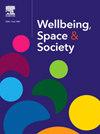从神经解码到设计干预:通过神经成像技术系统回顾人类对建筑空间的情感反应
IF 2.2
Q2 GEOGRAPHY
引用次数: 0
摘要
建筑空间深刻地塑造了人类的情感状态,但在设计框架中,空间-情感互动的神经机制仍未得到充分探索。本系统综述综合了17项神经影像学研究(2009-2023)的证据,以建立情感驱动空间设计的方法范式和神经相关性。遵循PRISMA指南,我们确定了三个关键发现:(1)方法趋同:脑电图在神经建筑学研究中占主导地位(83.3%的研究),主要与虚拟现实(66.7%)配对进行动态情绪跟踪,而现实世界评估仅占8.3%;(2)神经机制:空间比例(宽深比)、曲线形式和开放性通过α/β振荡和前扣带皮层激活显著调节松弛-觉醒平衡,而审美评价参与视觉空间网络(楔前叶、中颞回)和奖励回路(腹侧纹状体);(3)设计阈值:窗墙比(0.4-0.6)和空间比例(1.6:1)等经验参数成为情感导向设计的神经生理学基准。这篇综述强调了迫切需要整合EEG、fMRI和行为度量的多模态框架来解码复杂的空间相互作用。未来的研究应优先考虑纵向神经可塑性研究、设计参数优化计算模型和以神经为基础的设计指南。这项工作通过弥合神经科学见解和建筑实践之间的差距,推进了从直觉驱动到神经信息空间设计的范式转变。本文章由计算机程序翻译,如有差异,请以英文原文为准。
From neural decoding to design intervention: A systematic review of human emotional responses to architectural spaces through neuroimaging techniques
Architectural spaces profoundly shape human emotional states, yet the neural mechanisms underlying spatial-emotional interactions remain underexplored in design frameworks. This systematic review synthesizes evidence from 17 neuroimaging studies (2009-2023) to establish methodological paradigms and neural correlates of emotion-driven spatial design. Following PRISMA guidelines, we identified three critical findings: (1) Methodological convergence: electroencephalogram dominates neuro-architectural research (83.3 % studies), predominantly paired with virtual reality (66.7 %) for dynamic emotion tracking, while real-world assessments constitute only 8.3 %; (2) Neural mechanisms: Spatial proportions (width-depth ratios), curvilinear forms, and openness significantly modulate relaxation-arousal balance through α/β oscillations and anterior cingulate cortex activation, while aesthetic valuation engages visual-spatial networks (precuneus, middle temporal gyrus) and reward circuits (ventral striatum); (3) Design thresholds: Empirical parameters such as window-to-wall ratios (0.4–0.6) and spatial proportions (1.6:1) emerge as neurophysiological benchmarks for emotion-oriented design. The review highlights an urgent need for multimodal frameworks integrating EEG, fMRI, and behavioral metrics to decode complex spatial interactions. Future research should prioritize longitudinal neural plasticity studies, computational models of design parameter optimization, and neuroevidence-based design guidelines. This work advances a paradigm shift from intuition-driven to neuro-informed spatial design by bridging the gap between neuroscientific insights and architectural practice.
求助全文
通过发布文献求助,成功后即可免费获取论文全文。
去求助
来源期刊

Wellbeing Space and Society
Social Sciences-Social Sciences (miscellaneous)
CiteScore
2.70
自引率
0.00%
发文量
46
审稿时长
124 days
 求助内容:
求助内容: 应助结果提醒方式:
应助结果提醒方式:


